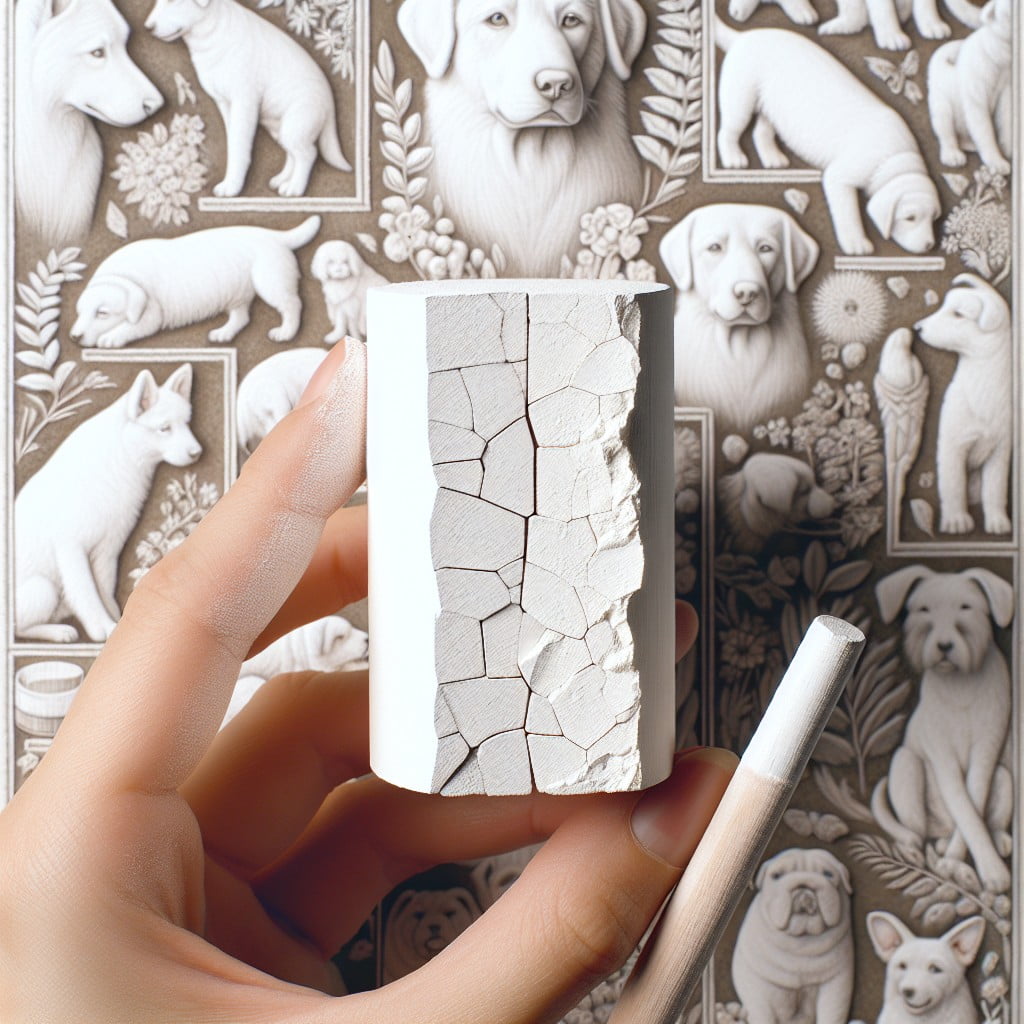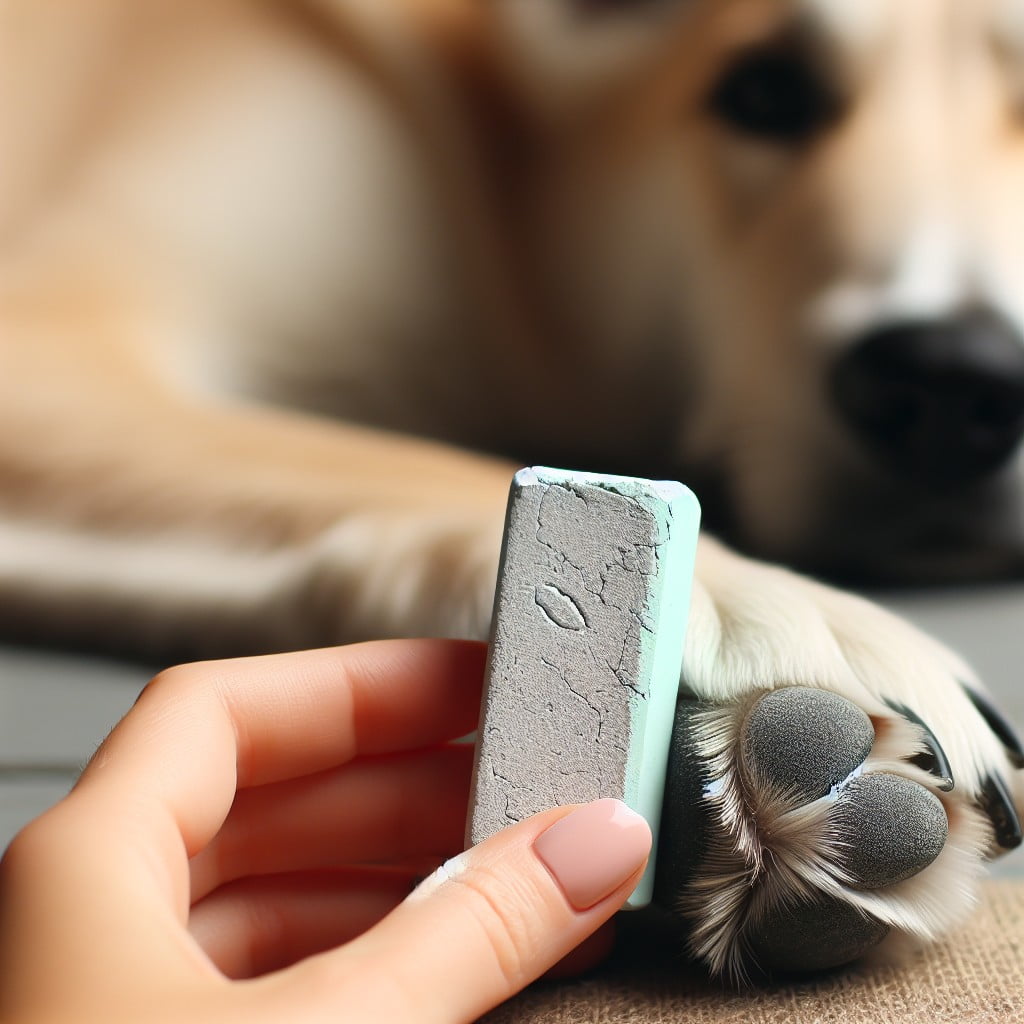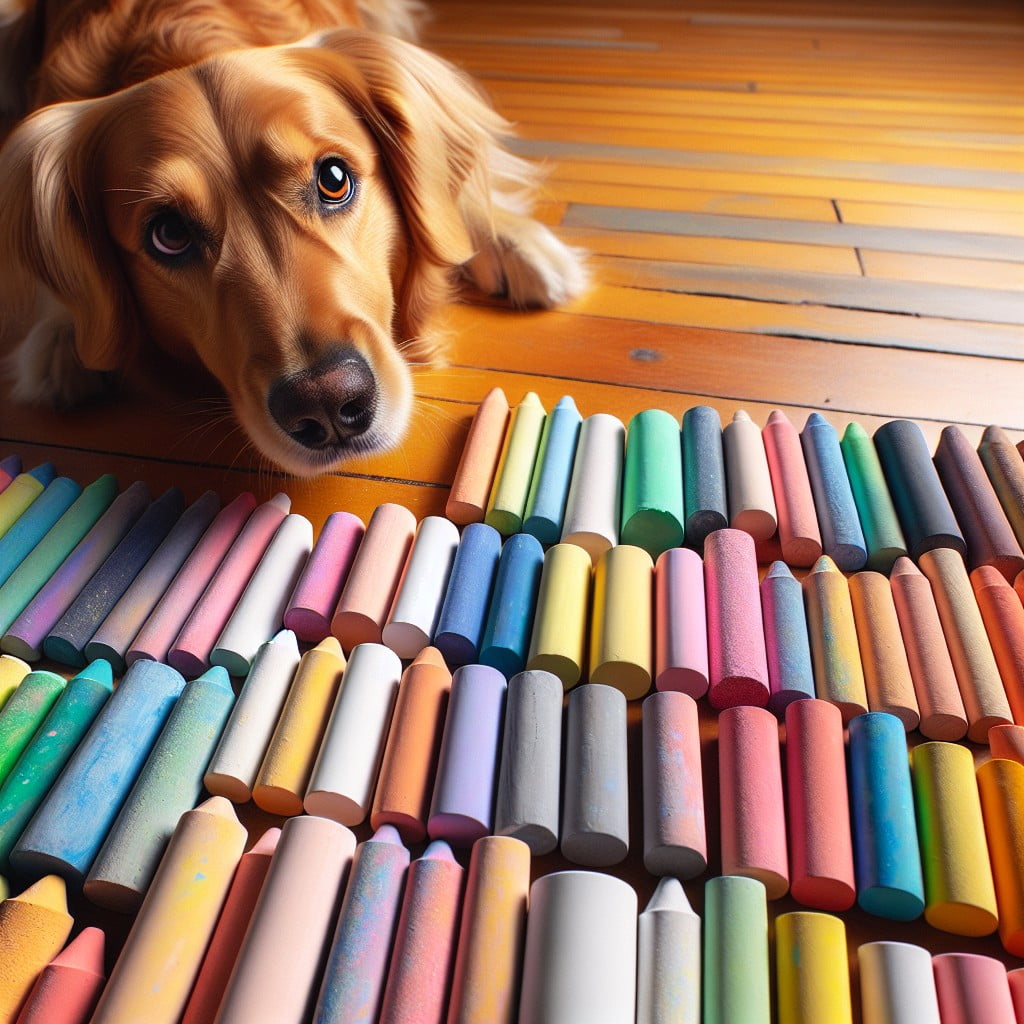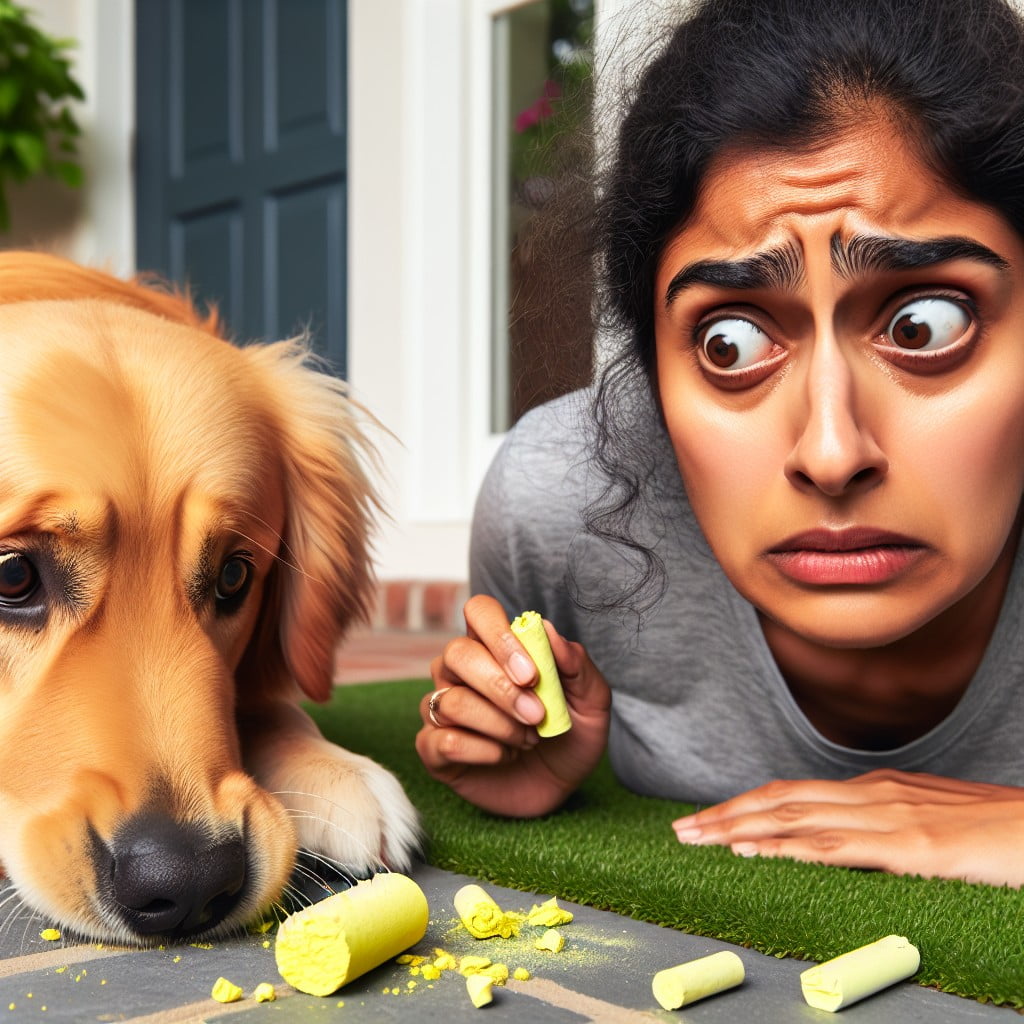Last updated on
While chalk is not typically toxic to dogs, ingestion can cause minor gastrointestinal upset such as vomiting or diarrhea, and in rare, extreme cases, respiratory distress if inhaled.
Key takeaways:
- Chalk is generally not toxic to dogs but can cause gastrointestinal upset.
- The composition of chalk varies and may contain additional ingredients.
- Different types of chalk have varying levels of toxicity.
- Chalk ingestion can lead to choking hazards and gastrointestinal blockages.
- Symptoms of chalk ingestion in dogs can include vomiting and diarrhea.
Composition of Chalk

Chalk is primarily composed of calcium sulfate (gypsum) or calcium carbonate (CaCO3), substances found in various minerals such as alabaster and limestone.
Traditionally used in classroom settings and for outdoor art, calcium carbonate chalk is soft, white, and non-toxic, making it generally safe if accidentally ingested in small amounts by dogs.
Additionally, it often includes binding agents to hold its shape and may contain trace amounts of other minerals, which contribute to its texture and durability.
With its low solubility in water, chalk isn’t easily absorbed into the bloodstream, reducing the risk of poisoning.
However, the specific composition can vary depending on the type of chalk, which may alter its safety profile.
Chalk Ingredients and Canine Safety

Typical chalk is composed principally of calcium sulfate or calcium carbonate, substances commonly found in materials like gypsum and limestone.
Both are non-toxic and generally safe if ingested in small amounts by dogs. However, some chalk products may contain additional ingredients such as colorants or chemicals, which could pose a risk depending on their toxicity levels.
It’s the added compounds that pet owners should be vigilant about, as they can vary from one chalk product to another.
When a dog ingests a substantial quantity of chalk, the size of the pieces and the specific makeup can affect its safety. Large chunks may lead to choking hazards or cause intestinal blockages — situations that require immediate veterinary attention.
Smaller pieces or powdered forms are less likely to cause mechanical issues but may still lead to mild digestive upset, including vomiting or diarrhea.
In terms of chemical additives, while most are deemed safe in small quantities, prolonged exposure or large ingestions might lead to complications. Therefore, monitoring a dog’s interaction with chalk and promptly consulting with a veterinarian if accidental ingestion occurs is critical for ensuring the pet’s safety and well-being.
Chalk Varieties and Their Toxicities

Different types of chalk have unique compositions, which can influence their level of harm if ingested by dogs.
Sidewalk chalk, commonly used by children, is typically made from non-toxic materials such as gypsum or calcium sulfate. These substances pose minimal risk if consumed in small quantities.
Gym chalk is primarily composed of magnesium carbonate. While not highly toxic, it may cause stomach discomfort and, in large amounts, could lead to more serious issues like electrolyte imbalances.
Billiard chalk is often made with silica and aluminum oxide. These elements, when ingested, may irritate a dog’s digestive system, leading to mild gastrointestinal upset.
Artist chalk can include heavy metals like lead in older or specialized products, which can be toxic. Newer and safer versions are generally free of heavy metals, but caution is still advised as there can be considerable variability among different brands.
It’s important to remember that, while the risk of toxicity from these types of chalk may be low, there is still the potential for choking or gastrointestinal blockage, particularly with larger pieces. Monitoring your dog around these items and ensuring they cannot access them is the best preventative measure.
Sidewalk or Blackboard Chalk

Commonly used by children in schools and for play, sidewalk and blackboard chalk is typically made from calcium sulfate or calcium carbonate—minerals that are non-toxic. When a dog ingests small amounts of these types of chalk, serious poisoning is unlikely. However, this doesn’t mean it’s completely safe; a large amount can cause stomach discomfort or result in a mess when it passes through the digestive system and is expelled.
Moreover, since these kinds of chalk are often brightly colored, it’s important to be aware that the pigments used, while generally safe, could contain contaminants depending on the source and manufacturing standards.
If your canine companion nibbles on a piece of sidewalk or blackboard chalk, monitor them for any signs of distress. Symptoms may include coughing, vomiting, or diarrhea, indicating a mild digestive upset. If you spot any changes in your pet’s behavior or health following chalk ingestion, contacting your vet is advisable for further guidance.
To prevent such issues, it’s best to keep chalk out of reach and supervise your dog during playtime, especially outdoors or around children’s play areas.
Gym Chalk
Gym chalk, primarily composed of magnesium carbonate, is used by athletes to enhance grip by absorbing moisture. It’s generally considered non-toxic; however, just because a substance is non-toxic to humans doesn’t mean it’s safe for dogs.
If ingested, the primary concern is not toxicity but rather the potential for stomach upset or digestive blockages, especially in small breeds or puppies. The symptoms to look out for include vomiting, diarrhea, and a lack of appetite.
If your dog does ingest a small amount of gym chalk, monitor them closely for any changes in behavior or bowel movements. While a one-time small intake might not cause serious harm, repeated ingestion or large amounts could lead to complications. Always keep gym items stored away from curious canines. Should your dog consume a significant quantity or exhibit distress, contact your veterinarian promptly.
Billiard Chalk
Billiard chalk is often misconceived as being similar to the standard calcium carbonate found in classroom chalk; however, it’s primarily composed of fine abrasives like silica and has a distinct formulation to reduce friction between the pool cue tip and the ball.
While not inherently toxic, ingestion can lead to minor gastrointestinal upset in dogs. The potential irritants in billiard chalk could cause symptoms such as diarrhea or vomiting if consumed in large quantities.
It’s important for pet owners to keep billiard rooms inaccessible to dogs to prevent any accidental ingestion. If a dog does consume billiard chalk, monitoring for any changes in behavior or bowel movements is crucial, and contacting a veterinarian for advice on the next best steps would be prudent.
Artist Chalk
Artist chalk often contains rich pigments and may include additional substances to enhance texture and adherence. When considering potential toxicity, it’s important to recognize that these ingredients differentiate artist chalk from its simpler counterparts.
- Pigments and Metals: Some artist chalks contain heavy metals to achieve vibrant colors. Metals like lead, cadmium, or chromium, while typically bound within the chalk, could pose a risk if ingested in significant amounts.
- Respiratory Irritants: Fine dust from artist chalk may also cause respiratory irritation if inhaled by dogs, especially in a poorly ventilated space.
- Oral Irritants: While a small, accidental ingestion of artist chalk may not immediately poison a dog, the gritty texture can cause oral discomfort or act as an irritant to the digestive tract.
- Ingestion and Symptoms: If you suspect your dog has ingested artist chalk, monitor for symptoms such as vomiting, diarrhea, or changes in behavior, which signal gastrointestinal upset or potential toxicity.
- Washable Chalks: Washable variants of artist chalk are typically less toxic but still can cause digestive upset due to dyes and other non-toxic ingredients.
For dogs with a penchant for chewing on non-food items, keeping artist supplies out of reach can prevent accidental ingestion. Always consider the specifics of the chalk in use and consult with a veterinarian if you have concerns about toxicity.
Choking Hazard From Chalk Ingestion
While it may be a relief to know that chalk is not highly toxic, the physical size and shape of chalk pieces pose a real threat. Dogs, especially curious puppies, can easily bite off a chunk large enough to obstruct their airway.
Here are some key points to consider:
- Dogs do not chew their food as thoroughly as humans, making them more susceptible to choking.
- Chalk can break into sharp fragments that might harm a dog’s throat on the way down.
- An obstruction in the airway can quickly turn into an emergency situation requiring immediate veterinary attention.
Monitor playtime and ensure all art supplies are out of reach to minimize these risks. If you suspect your dog has ingested a large piece of chalk and is acting distressed, contact your veterinarian swiftly.
Gastrointestinal Blockage Concerns
If a dog ingests large pieces of chalk, there’s a potential risk for a gastrointestinal blockage. This occurs when a foreign object, such as chalk, becomes lodged in the digestive tract, preventing the normal passage of food and fluids.
The following points outline the crucial aspects of this concern:
- Obstruction Location: Blockages can occur at any point in the stomach or intestines, with varying levels of severity.
Symptoms to Watch For: Be alert for signs such as vomiting, decreased appetite, lethargy, and abdominal pain. These symptoms often indicate a digestive disturbance that may be due to an obstruction.
Vet Assessment Is Vital: A veterinarian can diagnose a blockage using physical exams, X-rays, or ultrasound. Early detection is key to preventing more serious complications.
Treatment Options: The course of treatment depends on the obstruction’s size and location. While some blockages may pass on their own, others may require endoscopic removal or even surgical intervention.
Prompt attention to these symptoms and swift veterinary care can be crucial in preventing long-term health issues or life-threatening situations.
Digestive Issues From Chalk Consumption
Chalk eating may lead to mild or moderate digestive discomfort in dogs. Some common symptoms include:
- Diarrhea: Chalk’s non-digestible nature may irritate the stomach lining, resulting in loose stools.
- Vomiting: As the body attempts to reject the foreign material, dogs might vomit after ingesting chalk.
- Stomach Pain: Dogs could show signs of abdominal discomfort due to the indigestible chalk.
- Loss of Appetite: Dogs may experience a temporary disinterest in food as their gastrointestinal system deals with the chalk.
- Constipation: If the chalk forms a blockage, it might make bowel movements difficult for the dog.
Owners who notice these symptoms should provide their dogs with plenty of water, which may help ease the transit of chalk through the digestive system, and consult a veterinarian for guidance on specific treatment options.
Immediate Steps Post-Ingestion of Chalk
If your dog has ingested chalk, observe them closely for any distress signs, which may include coughing, vomiting, or a change in behavior. Remove any remaining chalk pieces to prevent further consumption. Offer your dog water to help ease chalk passage through the digestive system. Do not induce vomiting unless directed by a veterinarian; doing so could cause additional complications.
Contact your veterinarian promptly, providing details about the type of chalk ingested and the amount. They may want to examine your dog to ensure there’s no respiratory obstruction or risk of toxin exposure, especially if the chalk contains potentially harmful heavy metals or other additives.
Monitor your dog for gastrointestinal discomfort and unusual stool. Constipation or diarrhea might occur as the chalk passes through the digestive tract. In the meantime, ensure your pet continues with normal hydration and nutrition, unless vet-advised dietary changes are necessary.
Keep your vet’s emergency contact information handy for quick access in any unforeseen escalation of the situation. Remember, swift and calm action is pivotal to ensuring your dog’s safety after ingesting non-food items like chalk.
Intervention and Treatment Options
If a dog has ingested chalk, monitor for signs of distress such as coughing, vomiting, or a lack of appetite. Contact your veterinarian promptly for guidance. In some cases, they may advise you to induce vomiting at home with 3% hydrogen peroxide under their direction. However, this should never be attempted without veterinary approval, as it can be dangerous in certain situations.
Your vet might suggest bringing your pet in for an examination. At the clinic, they may perform diagnostic tests like an X-ray to check for any gastrointestinal blockage. Treatment could involve fluids to aid in passing the chalk through the system or, in more severe cases, surgical intervention to remove any obstructions.
Providing your dog with a high-fiber diet temporarily could help to move the chalk along if it’s not causing a blockage. Ensure your dog has access to clean water to keep them hydrated, as this can support digestive health during this period.
Throughout this time, keep an especially close watch on your dog’s bowel movements and overall behavior. Any changes or inability to pass stool should be reported to your veterinarian immediately. Remember that a swift response can make a significant difference in your dog’s recovery.
Preventative Measures to Discourage Chalk Eating
Effective training is crucial in teaching dogs what is safe for them to chew on. Introduce a firm ‘leave it’ command, rewarding your dog when they obey it. Provide suitable chew toys that satisfy their need to gnaw, deterring them from picking up non-food items like chalk.
Store chalk and other art supplies out of reach. Consider high shelves or locked cabinets that are dog-proof. Similarly, if your dog spends time outdoors, supervise their play, especially in areas where chalk is used.
Secure your dog when you can’t provide supervision. Use child safety gates or a crate trained environment, ensuring they don’t have access to chalk when left alone.
Remove chalk residue. After use on sidewalks or blackboards, wash the area down to prevent your dog from licking or picking up lingering pieces.
Consistency is key. Maintain these preventative habits consistently, and your dog is less likely to develop an interest in eating chalk.
Sidewalk Chalk Ingestion
If your dog happens to sneak a bite of sidewalk chalk, the good news is that it’s generally made from non-toxic materials. These materials typically include calcium carbonate, which is not harmful to dogs in small amounts. However, large quantities can cause stomach upset as your furry friend’s digestive system is not equipped to process this substance efficiently.
Here are a few key points to consider if your dog ingests sidewalk chalk:
- Monitor for Symptoms: Keep an eye on your dog for signs of discomfort, such as drooling, lack of appetite, or vomiting. Though these symptoms may pass as the chalk moves through their digestive system, persistent or severe signs merit a vet visit.
- Hydration is Key: Encourage your dog to drink water. This can help to move the chalk through the intestines and alleviate constipation or discomfort.
- Chalk Size Matters: Be mindful of choking hazards, particularly with smaller dogs or if large pieces of chalk were ingested.
- Avoiding Recurrence: Once you’ve dealt with the immediate ingestion, securing chalk in closed containers or high shelves can prevent your dog from a repeat snack.
In any case where you’re unsure about your pet’s reaction to ingested substances, don’t hesitate to contact your veterinarian. They can offer guidance based on the size of your dog and the amount of chalk ingested.
FAQ
What happens when dogs eat chalk?
When dogs ingest chalk, it can potentially result in various health issues such as gastric upset, vomiting, diarrhea, and in severe cases, intestinal obstructions.
Is cockroach chalk harmful for dogs?
Cockroach chalk, such as Laxman Rekhaa, is non-toxic to dogs if they merely touch it, however, it can be harmful if ingested.
What is pica in puppies?
Pica in puppies is a behavioral or medical condition characterized by the ingestion of non-food items, potentially stemming from nutrient deficiencies, anxiety, or boredom.
Can chalk ingestion lead to long-term health issues in dogs?
Yes, ingestion of chalk can lead to long-term health issues in dogs such as gastrointestinal blockage and toxicity due to its calcium content.
Are there specific types of chalk more harmful to dogs than others?
Yes, calcium carbonate-based chalk is generally less harmful to dogs than selenite or gypsum chalk.
What are the immediate steps to take if a puppy consumes chalk?
If a puppy consumes chalk, immediately consult a vet and monitor the puppy for reactions while ensuring the puppy has access to plenty of fresh water.
Recap:




